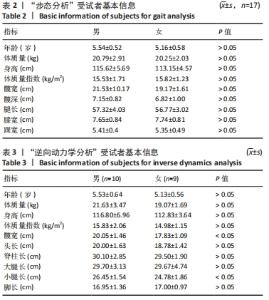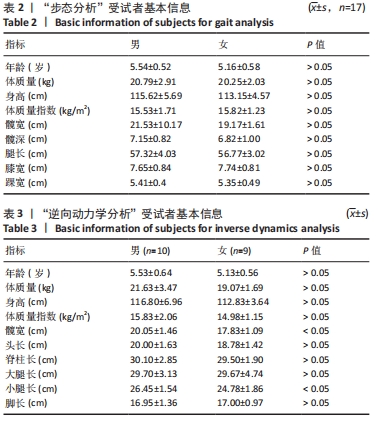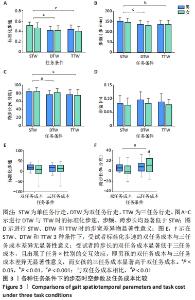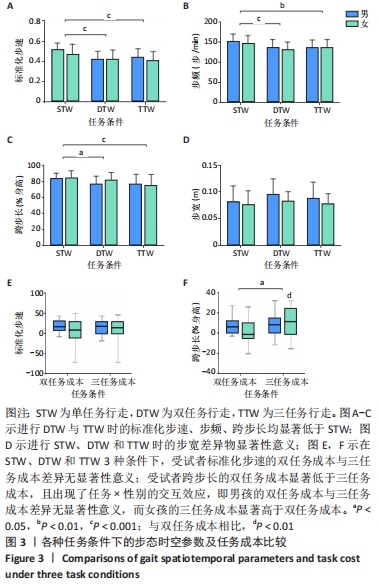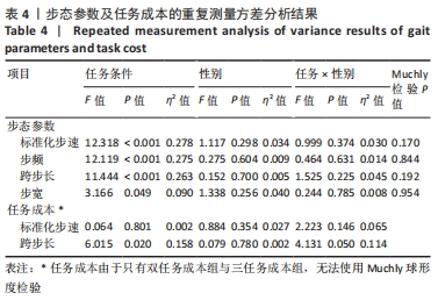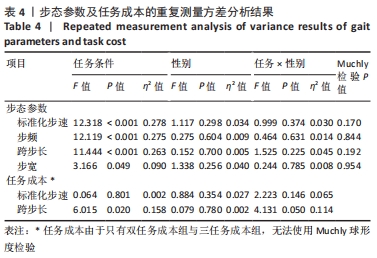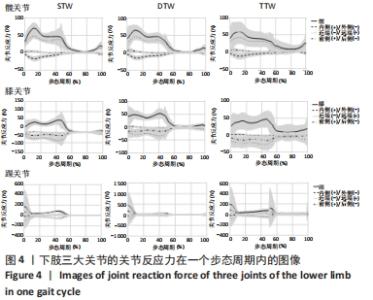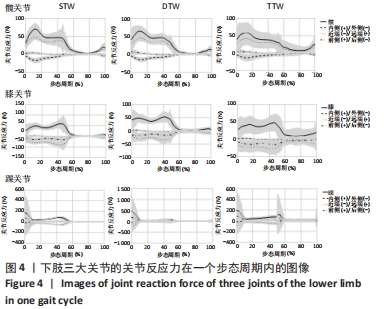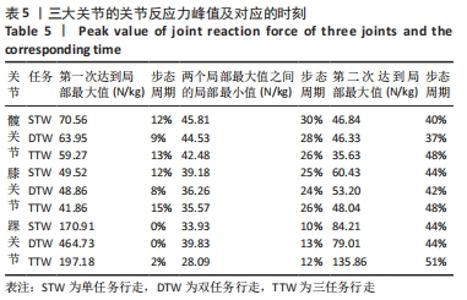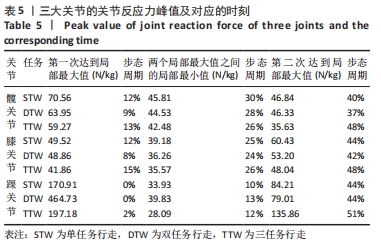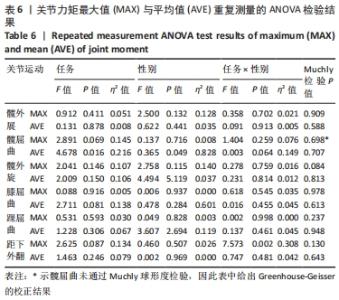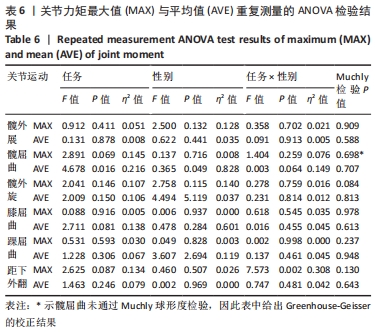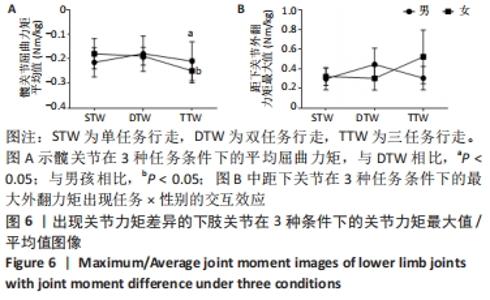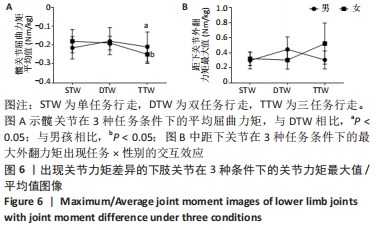Chinese Journal of Tissue Engineering Research ›› 2023, Vol. 27 ›› Issue (4): 505-512.doi: 10.12307/2022.800
Previous Articles Next Articles
Gait and biomechanical characteristics of lower limbs in multi-task walking of 4-6-year-old children
Liang Xiao, Zhao Panchao, Li Jiahui, Ji Zhongqiu, Jiang Guiping
- School of Physical Education and Sports, Beijing Normal University, Beijing 100875, China
-
Received:2021-10-08Accepted:2021-11-20Online:2023-02-08Published:2022-06-22 -
Contact:Ji Zhongqiu, MD, Doctoral supervisor, Professor, School of Physical Education and Sports, Beijing Normal University, Beijing 100875, China -
About author:Liang Xiao, Master candidate, School of Physical Education and Sports, Beijing Normal University, Beijing 100875, China -
Supported by:General Project of the National Social Science Foundation of China in 2020, No. 20BTY070 (to JGP)
CLC Number:
Cite this article
Liang Xiao, Zhao Panchao, Li Jiahui, Ji Zhongqiu, Jiang Guiping. Gait and biomechanical characteristics of lower limbs in multi-task walking of 4-6-year-old children[J]. Chinese Journal of Tissue Engineering Research, 2023, 27(4): 505-512.
share this article
Add to citation manager EndNote|Reference Manager|ProCite|BibTeX|RefWorks
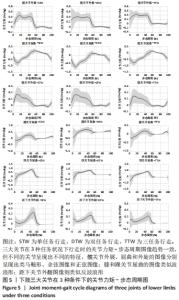
三大关节的关节反应力-步态周期图像呈现出相同的特点,即2个局部最大值中间出现局部最小值。结合图表可知,髋膝踝三关节在3种任务条件下的峰值时刻各具一致性。髋关节约在11%步态周期时达第一次最大值(MAX1),并为整个步态周期的最大值,此时右腿正处于刚触地之后的支撑阶段;在步态周期的42%左右达第二次最大值(MAX2),此时对应右腿离地阶段。膝关节的情况类似,第一次达最大值约在步态周期的12%;第二次达最大值在步态周期的45%,为整个步态周期的最大值。踝关节在右腿脚跟触地的瞬间便达到第一次最大值,即为整个步态周期的最大值;在46%步态周期左右达到第二次最大值,此时三任务行走的峰值高于单任务与双任务行走,但差异无显著性意义。 2.5.2 关节力矩 髋、膝、踝三大关节在一个步态周期内的关节力矩图像见图5,包括髋关节外展、屈曲和外旋,膝、踝关节屈曲和距下关节外翻运动。由图可知,行走时三大关节在3种任务状况下各自运动水平的关节力矩-步态周期图像趋势一致。髋关节外展时,关节力矩图像类似马鞍形;髋关节屈曲力矩图类似余弦图像;而髋关节外旋力矩图类似正弦图像;膝、踝关节屈曲的图像走势一致,类似于波浪形;而距下关节外翻时的关节力矩图像呈现出反波浪形。 "
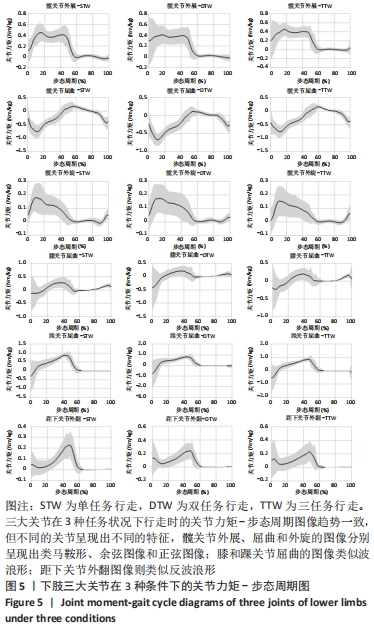
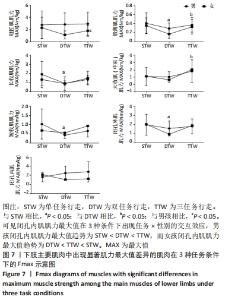
2.5.3 肌肉力 对选取的26块下肢肌肉在一个步态周期内肌肉力的最大值进行重复测量ANOVA后的结果显示,只有少数肌肉显示出性别差异或任务差异或任务×性别的交互效应,见图7,具体表现在:①缝匠肌出现了显著的性别差异,男孩的缝匠肌肌力明显高于女孩(F=4.822,P=0.042,η2=0.221);②股薄肌、长收肌、大收肌中束、短收肌和闭孔外肌均出现了显著的任务差异,其中,股薄肌、长收肌、短收肌和闭孔外肌的DTW的肌力最大值明显低于STW和TTW(F=5.682,P=0.007,η2=0.251;F=4.085,P=0.026,η2=0.194;F=3.874,P=0.031,η2=0.186;F=5.634,P=0.008,η2=0.249),股薄肌和大收肌中束肌力最大值表现为TTW显著高于DTW(F=5.682,P=0.007,η2=0.251;F=4.559,P=0.018,η2=0.211),而DTW与STW之间无明显差异;③闭孔内肌出现任务×性别的交互效应(F=4.978,P=0.013,η2=0.227),男孩的肌力最大值趋势为STW < DTW < TTW,而女孩的肌力最大值趋势为DTW < TTW < STW;其余未见显著性差异。"
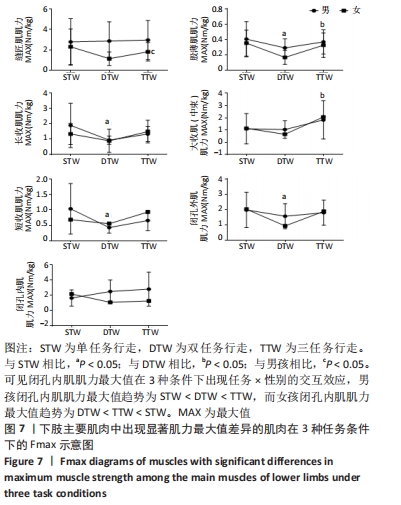
| [1] SHAIKH AA, SHAH K. Reading and texting while walking: effect on gait indices in healthy young females. Int J Physiother. 2019;6(2):23-27. [2] YOGEV-SELIGMANN G, HAUSDORFF JM, GILADI N. The role of executive function and attention in gait. Mov Disord. 2008;23(3):329-342. [3] SUTHERLAND DH, OLSHEN R, COOPER L, et al. The development of mature gait. J Bone Joint Surg Am. 1980;62(3):336-353. [4] ADOLPH KE, VEREIJKEN B, SHROUT PE. What Changes in Infant Walking and Why. Child Dev. 2003;74(2):475-497. [5] REILLY DS, VAN DONKELAAR P, SAAVEDRA S, et al. Interaction between the development of postural control and the executive function of attention. J Mot Behav. 2008;40(2):90-102. [6] SAMSON W, VAN HAMME A, DESROCHES G, et al. Biomechanical maturation of joint dynamics during early childhood: updated conclusions. J Biomech. 2013; 46(13):2258-2263. [7] MCFADYEN BJ, GAGNE ME, COSSETTE I, et al. Using dual task walking as an aid to assess executive dysfunction ecologically in neurological populations: A narrative review. Neuropsychol Rehabil. 2017;27(5):722-743. [8] ABERNETHY B. Dual-task methodology and motor skills research: Some applications and methodological constraints. J Hum Mov Stud. 1988;14(3):101-132. [9] LUNDIN-OLSSON L, NYBERG L, GUSTAFSON Y. “Stops walking when talking” as a predictor of falls in elderly people. Lancet. 1997;349(9052):617. [10] 金成敏,曲峰,赵享楠,等.双任务下楼梯行走时对下肢肌肉活动表现及加速度近似熵指数的影响[J].天津体育学院学报,2018,33(4):362-368. [11] 王莉,于卫华,徐忠梅.社区老年人双重任务行走步态特征与跌倒的关系研究[J].护理学杂志,2016,31(15):76-79. [12] 徐忠梅,于卫华,吴梦余,等.老年2型糖尿病患者双重任务行走步态特征及其与害怕跌倒的相关性研究[J].中华护理杂志,2018,53(1):22-26. [13] BOONYONG S, SIU KC, VAN DONKELAAR P, et al. Development of postural control during gait in typically developing children: the effects of dual-task conditions. Gait Posture. 2012;35(3):428-434. [14] 段蕾蕾,董建群.世界预防儿童伤害报告中文版[M].北京:人民军医出版社, 2012:3-12. [15] CHERNG RJ, LIANG LY, CHEN YJ, et al. The effects of a motor and a cognitive concurrent task on walking in children with developmental coordination disorder. Gait Posture. 2009;29(2):204-207. [16] KATZ-LEURER M, ROTEM H, KEREN O, et al. Effect of concurrent cognitive tasks on gait features among children post-severe traumatic brain injury and typically-developed controls. Brain Inj. 2011;25:581-586. [17] HOFMAN M, KOLEJEWSKA A, GREVEN J, et al. Gait analysis and muscle weight analysis after lower extremity fractures in a small animal model. Gait Posture. 2020;77:207-213. [18] NIINIMAKI S, NARRA N, HARKONEN L, et al. The relationship between loading history and proximal femoral diaphysis cross-sectional geometry. Am J Hum Biol. 2017;29(4):e22965. [19] PAUWELS F. Biomechanics of the normal and diseased hip - An atlas, 1 edn. Springer, Berlin, Heidelberg, 1976. [20] BITSAKOS C, KERNER J, FISHER I, et al. The effect of muscle loading on the simulation of bone remodelling in the proximal femur. J Biomech. 2005;38(1):133-139. [21] DAVY DT, KOTZAR GM, BROWN RH, et al. Telemetric force measurements across the hip after total arthroplasty. J Bone Joint Surg Am. 1988;70(1):45-50. [22] YADAV P, SHEFELBINE SJ, GUTIERREZ-FAREWIK EM. Effect of growth plate geometry and growth direction on prediction of proximal femoral morphology. J Biomech. 2016;49(9):1613-1619. [23] LENAERTS G, DE GROOTE F, DEMEULENAERE B, et al. Subject-specific hip geometry affects predicted hip joint contact forces during gait. J Biomech. 2008; 41(6):1243-1252. [24] HAGMANN-VON ARX P, MANICOLO O, PERKINSON-GLOOR N, et al. Gait in Very Preterm School-Aged Children in Dual-Task Paradigms. PLoS One. 2015;10(12): e0144363. [25] CHERNG RJ, LIANG LY, HWANG IS, et al. The effect of a concurrent task on the walking performance of preschool children. Gait Posture. 2007;26(2):231-237. [26] HOF AL. Scaling gait data to body size. Gait Posture. 1996;4:222-223. [27] KELLY VE, JANKE AA, SHUMWAY-COOK A. Effects of instructed focus and task difficulty on concurrent walking and cognitive task performance in healthy young adults. Exp Brain Res. 2010;207(1-2):65-73. [28] COHEN J. Statistical Power Analysis for the Behavioral Sciences, 2nd edit edn. Lawrence Erlbaum Associates: New York, 1988. [29] BOND JM, MORRIS M. Goal-directed secondary motor tasks: Their effects on gait in subjects with Parkinson disease. Arch Phys Med Rehabil. 2000;81(1):110-116. [30] CHERNG RJ, LIANG LY, CHEN YJ, et al. The effects of a motor and a cognitive concurrent task on walking in children with developmental coordination disorder. Gait Posture. 2009;29(2):204-207. [31] HU M, ZHOU N, XU B, et al. Quantifying intra-limb coordination in walking of healthy children aged three to six. Gait Posture. 2016;50:82-88 [32] MÜLLER J, MÜLLER S, BAUR H, et al. Intra-individual gait speed variability in healthy children aged 1-15 years. Gait Posture. 2013;38(4):631-636. [33] TOMBU M, JOLICŒUR P. A central capacity sharing model of dual-task performance. J Exp Psychol Hum Percept Perform. 2003;29(1):3-18. [34] WICKENS CD. Multiple resources and mental workload. Hum Factors. 2008;50(3): 449-455. [35] BAUBY CE, KUO AD. Active control of lateral balance in human walking. J Biomech. 2000;33(11):1433-1440. [36] GHAI S, GHAI I, EFFENBERG AO. Effects of dual tasks and dual-task training on postural stability: a systematic review and meta-analysis. Clin Interv Aging. 2017; 12:557-577. [37] SKUBICH J, PISZCZATOWSKI S. Model of loadings acting on the femoral bone during gait. J Biomech. 2019;87:54-63. [38] TOTTORI N, SUGA T, HORI M, et al. Impact of moment arm on torque production of the knee extensors in children. Physiol Rep. 2020;8(17):e14521. [39] GANLEY KJ, POWERS CM. Intersegmental dynamics during the swing phase of gait: a comparison of knee kinetics between 7 year-old children and adults. Gait Posture. 2006;23(4):499-504. [40] SUTHERLAND DH. The development of mature gait. Gait Posture. 1997;6:163-170. [41] SCHLOEMER SA, THOMPSON JA, SILDER A, et al. Age-Related Differences in Gait Kinematics, Kinetics, and Muscle Function: A Principal Component Analysis. Ann Biomed Eng. 2017;45(3):695-710. [42] DI NARDO F, LAUREATI G, STRAZZA A, et al. Is child walking conditioned by gender? Surface EMG patterns in female and male children. Gait Posture. 2017;53:254-259. |
| [1] | Li Yaping, Liu Hong, Gao Zhen, Chen Xiaolin, Huang Wujie, Jiang Zheng. Three-dimensional motion analysis of lower limb biomechanical performance in Tai Chi practitioners accompanied by knee joint pain [J]. Chinese Journal of Tissue Engineering Research, 2023, 27(4): 520-526. |
| [2] | Li Shihao, Li Qi, Li Zhen, Zhang Yuanyuan, Liu Miaomiao, Ouyang Yi, Xu Weiguo. Plantar pressure and gait analysis in patients with anterior cruciate ligament injury and reconstruction [J]. Chinese Journal of Tissue Engineering Research, 2023, 27(4): 626-631. |
| [3] | Zhang Jichao, Dong Yuefu, Mou Zhifang, Zhang Zhen, Li Bingyan, Xu Xiangjun, Li Jiayi, Ren Meng, Dong Wanpeng. Finite element analysis of biomechanical changes in the osteoarthritis knee joint in different gait flexion angles [J]. Chinese Journal of Tissue Engineering Research, 2022, 26(9): 1357-1361. |
| [4] | Bai Zixing, Cao Xuhan, Sun Chengyi, Yang Yanjun, Chen Si, Wen Jianmin, Lin Xinxiao, Sun Weidong. Construction and biomechanical analysis of ankle joint finite element model in gait cycle [J]. Chinese Journal of Tissue Engineering Research, 2022, 26(9): 1362-1366. |
| [5] | Liu Feng, Feng Yi. Finite element analysis of different Kirschner wire tension bands on transverse patella fractures during gait cycle [J]. Chinese Journal of Tissue Engineering Research, 2022, 26(9): 1367-1371. |
| [6] | Li Kun, Gao Erke, Xiong Feng, Wang Xing, Wu Danqi, Li Zhijun, Zhang Shaojie, Liu Yanan, Duo Lan, Li Ziyu. Feasibility of axial transpedicle screw internal fixation in children aged 1 to 6 years [J]. Chinese Journal of Tissue Engineering Research, 2022, 26(9): 1383-1387. |
| [7] | Liu Gang, Ma Chao, Wang Le, Zeng Jie, Jiao Yong, Zhao Yi, Ren Jingpei, Hu Chuanyu, Xu Lin, Mu Xiaohong. Ankle-foot orthoses improve motor function of children with cerebral palsy: a Meta-analysis based on 12 randomized controlled trials [J]. Chinese Journal of Tissue Engineering Research, 2022, 26(8): 1299-1304. |
| [8] | Shao Yangyang, Zhang Junxia, Jiang Meijiao, Liu Zelong, Gao Kun, Yu Shuhan. Kinematics characteristics of lower limb joints of young men running wearing knee pads [J]. Chinese Journal of Tissue Engineering Research, 2022, 26(6): 832-837. |
| [9] | Shan Sharui, Huang Xuming, Zhang Mingxing, Wang Xiukun, Zheng Xiang, Bao Sairong, Hong Feng. Three-dimensional gait analysis of low-frequency repetitive transcranial magnetic stimulation for post-stroke hemiplegia [J]. Chinese Journal of Tissue Engineering Research, 2022, 26(5): 762-767. |
| [10] | Bai Xiaotian, Jiang Tao, Huo Hongfeng, Li Zongtao. Biomechanical characteristics of foot balance during walking support [J]. Chinese Journal of Tissue Engineering Research, 2022, 26(36): 5787-5791. |
| [11] | She Jian, Zhao Jing, Zhang Jiaming, Xia Haisha, Zhong Dongling, Li Yuxi, Zheng Zhong, Li Juan, Jin Rongjiang. Visualization analysis of literature on eye tracking in cognitive behaviors of autistic patients [J]. Chinese Journal of Tissue Engineering Research, 2022, 26(35): 5724-5732. |
| [12] | Song Yan, Zheng Kun, Wei Haoxin, Lu Dezhi, Xu Yuanjing, Wang Xiaowen, Wang Jinwu. reliability of flat feet evaluated by foot posture index and its application in three-dimensional printing insoles [J]. Chinese Journal of Tissue Engineering Research, 2022, 26(3): 344-349. |
| [13] | Wang Chong, Zhang Meiying, Zhou Jian, Lao Kecheng. Early gait changes after total hip arthroplasty through direct anterior approach and posterolateral approach [J]. Chinese Journal of Tissue Engineering Research, 2022, 26(3): 359-364. |
| [14] | Pan Hao, Zhao Huihui, Wang Jiangjing, Wang Feng, Wang Peng, Shi Qiuling, Guo Jin, Li Lin, Liu Guoqiang. Comparison of kinematic alignment and mechanical alignment to guide gait after total knee arthroplasty [J]. Chinese Journal of Tissue Engineering Research, 2022, 26(3): 365-370. |
| [15] | Zheng Wei, Sun Libing, Xiong Yingzhe, Zhang Yichi, You Jing, Huang Wenqi, Guo Yanhua, Liu Hongjun. Effect of eccentric strengthening on hamstring strength: a Meta-analysis [J]. Chinese Journal of Tissue Engineering Research, 2022, 26(29): 4749-4756. |
| Viewed | ||||||
|
Full text |
|
|||||
|
Abstract |
|
|||||


